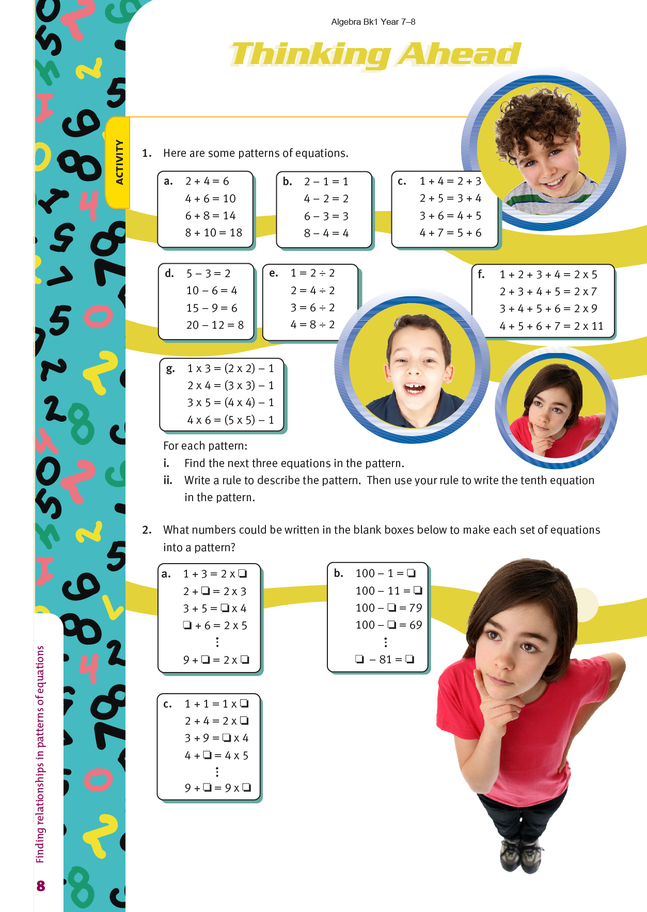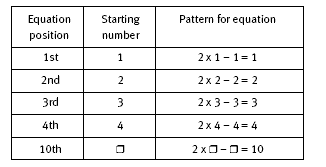This is a level 3 algebra strand link activity from the Figure It Out series.
A PDF of the student activity is included.
Click on the image to enlarge it. Click again to close. Download PDF (345 KB)
find a relationship in a set of equations
use words to describe a rule
FIO, Link, Algebra, Book One, Thinking Ahead, page 8
These activities provide opportunities for pattern spotting and for writing numerical expressions in alternative ways. Some of the patterns suggest short cuts for making calculations. For example, in question 1f, the equation 4 + 5 + 6 + 7 = 2 x 11 is used to calculate the sum of 4 consecutive numbers. The rule is: the sum of 4 consecutive numbers is 2 times the sum of the first and last numbers. So, for example, 249 + 250 + 251 + 252 = 2 x (249 + 252), which is 2 x 501 or 1 002. Another rule, the sum of 4 consecutive numbers is 2 times the sum of the middle 2 numbers, would do equally well.
While students are often quick to see patterns, they often have considerable difficulty writing rules for patterns in words. This is especially the case for those with English as a second language. The students are likely to benefit from talking with others about the patterns they notice as they draft the rules. It is this process of talking and explaining that is the key to this work.
As the students become more accomplished at writing the rules in words, it may be possible to introduce the symbolic notations that are customarily used in algebra. However, algebraic notation has its own difficulties. For example, students are often confused by expressions such as n + 2 or n – 3 and so on, where a literal symbol and a number are combined by an addition or subtraction operation. They prefer to get an answer similar to 2 + 3 = 5 and sometimes write, incorrectly, that n + 2 = n2. For many, it seems a little odd that n + 2 is just n + 2 when 2 x n is written as 2n. (2n is the same as n + n, as in arithmetic. For example, 2 x 13 = 13 + 13.) It is also customary in algebra to put the number before the literal symbol, so we write
4n rather than n4.
In question 1a, the pattern is more evident when the equations are written in the following way:
2 + 4 = 2 + (2 + 2) = 2 + 2 + 2 = 2 x 2 + 2 = 6
4 + 6 = 4 + (4 + 2) = 4 + 4 + 2 = 2 x 4 + 2 = 10
6 + 8 = 6 + (6 + 2) = 6 + 6 + 2 = 2 x 6 + 2 = 14
8 + 10 = 8 + (8 + 2) = 8 + 8 + 2 = 2 x 8 + 2 = 18
This may help the students to see that the rule for the pattern can be expressed as “An even number plus the number 2 more than itself equals twice the number plus 2.” This is n + (n + 2) = 2n + 2, where n is any even number.
In question 1b, the rule for the pattern can be expressed as “Twice a number take away itself equals itself.” This is 2n – n = n. A pattern table may help students see how to figure out the tenth equation in the pattern.
Patterns in the table show that the number that goes in the in the tenth equation is 10. So, for example, the 100th equation would be 2 x 100 – 100 = 100.
In question 1c, the rule for the pattern can be expressed as “A number added to the number 3 more than itself equals 1 more than the number plus 2 more than the number.” Using algebraic language, the rule is n + (n + 3) = (n + 1) + (n + 2). Note that the left-hand side of the equation is n + (n + 3) = 2n + 3, and the righthand
side is (n + 1) + (n + 2) = 2n + 1 + 2 = 2n + 3. For this question, and for questions 1d, 1e, and 1f, the first equation is the equation with n = 1. So the tenth equation is the equation with n = 10. Similarly, the 100th equation is the equation with n = 100. For question 1c, the 100th equation is 100 + 103 = 101 + 102.
In question 1d, the rule for the pattern can be expressed as “5 times a number take away 3 times the number equals 2 times the number.” This can be written as 5n – 3n = 2n. The tenth equation is 5 x 10 – 3 x 10 = 2 x 10, which can be written more simply as 50 – 30 = 20.
In question 1e, the rule for the pattern can be expressed as “A number equals 2 times itself divided by 2.” It could also be expressed as “A number is half its double.” Algebraically, this is n = 2n ÷ 2.
In question 1f, the rule for the pattern can be expressed as “Any 4 consecutive numbers add up to 2 times the sum of the first and last numbers.” Using algebra, this is n + (n + 1) + (n + 2) + (n + 3) = 2[n + (n + 3)]. The first equation in the pattern is 1 + 2 + 3 + 4 = 2 x 5, with n = 1. So the tenth equation is
10 + 11 + 12 + 13 = 2 x (10 + 13)
= 2 x 23.
In question 1g, the rule for the pattern can be expressed as “A number times the number 2 more than itself equals the square of 1 more than the number, minus 1.” Algebraically, this is n(n + 2) = (n + 1)2 – 1. The tenth equation is 10 x 12 = 11 x 11 – 1. The 100th equation is 100 x 102 = 101 x 101 – 1.
In question 2, the students need to find either the value of the missing number or the numbers to make the total value on the left-hand side of the equation equal to the total value on the right-hand side of the equation. Where there are two numbers missing in an equation, the numbers can be found from the pattern in the
equations.
In question 2c, draw the students’ attention to the pattern in the second numbers on the left-hand side of these equations. Each second number is the square of the first number. And on the right-hand side, each second number is 1 more than the first number. The final equation is then 9 + 81 = 9 x 10.
Answers to activity
1. a. i. 10 + 12 = 22, 12 + 14 = 26, 14 + 16 = 30
ii. A possible rule is: an even number plus the number 2 more than itself equals twice the number plus 2. The tenth equation is 20 + 22 = 42.
b. i. 10 – 5 = 5, 12 – 6 = 6, 14 – 7 = 7
ii. Possible rule: twice a number take away itself equals itself. Tenth equation: 20 –10 = 10
c. i. 5 + 8 = 6 + 7, 6 + 9 = 7 + 8, 7 + 10 = 8 + 9
ii. Possible rule: a number added to the number 3 more than itself equals 1 more than the number plus 2 more than the number. Tenth equation: 10 + 13 = 11 + 12
d. i. 25 – 15 = 10, 30 – 18 = 12, 35 – 21 = 14
ii. Possible rule: 5 times a number take away 3 times the number equals 2 times the number. Tenth equation: 50 – 30 = 20
e. i. 5 = 10 ÷ 2, 6 = 12 ÷ 2, 7 = 14 ÷ 2
ii. Possible rule: a number equals 2 times itself divided by 2. Tenth equation: 10 = 20 ÷ 2
f. i. 5 + 6 + 7 + 8 = 2 x 13, 6 + 7 + 8 + 9 = 2 x 15, 7 + 8 + 9 + 10 = 2 x 17
ii. Possible rule: any 4 consecutive numbers add up to 2 times the sum of the first and
last numbers. Tenth equation: 10 + 11 + 12 + 13 = 2 x 23
g. i. 5 x 7 = (6 x 6) – 1, 6 x 8 = (7 x 7) – 1, 7 x 9 = (8 x 8) – 1
ii. Possible rule: a number times the number 2 more than itself equals the square of 1 more than the number, minus 1. Tenth equation: 10 x 12 = (11 x 11) – 1
2. a. 1 + 3 = 2 x 2
2 + 4 = 2 x 3
3 + 5 = 2 x 4
4 + 6 = 2 x 5
9 + 11 = 2 x 10
b. 100 – 1 = 99
100 – 11 = 89
100 – 21 = 79
100 – 31 = 69
100 – 81 = 19
c. 1 + 1 = 1 x 2
2 + 4 = 2 x 3
3 + 9 = 3 x 4
4 + 16 = 4 x 5
9 + 81 = 9 x 10

